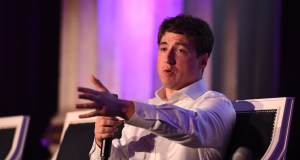IT leaders discuss cybersecurity, innovation at 2015 FedTalks
As the Patent and Trademark Office works to modernize its IT systems, the agency’s chief information officer said he had to eliminate a few words from his staff’s vocabulary.
“That first word was ‘no,’ and the second was ‘I can’t,’” he said.
Instead, he wanted his workers to focus on what they could deliver — and break down internal barriers so they could embrace industry practices like DevOps, which emphasizes rapid production, integration and delivery.
EPA CIO Ann Dunkin; moderator Craig Haskins, chief customer officer of Avaya Government Solutions; and USPTO CIO John Owens talked about innovating in government IT. (FedScoop)
He made the remarks at FedScoop’s annual FedTalks, held Tuesday in Washington, D.C., where more than two dozen technology execs from the public and private sectors took to the stage to discuss how IT could be better deployed to help the federal government.
These leaders met as the federal government IT faces a host of challenges: It’s still reeling from the massive hacks to the Office of Personnel Management’s systems, which exposed the data of millions of federal workers and their families. Agencies are working to implement plans for the Federal information Technology Acquisition Reform Act, a new law that consolidates IT budget authority to the department’s CIO. And all the while, they’re trying to determine how new ideas like cloud, big data and mobility fit into their strategic plans.
Many of these challenges were addressed by several speakers, including federal CIO Tony Scott, whose office is just coming off the cybersecurity “sprint” to bolster agency’s defenses in wake of the OPM hacks. He talked about his plans to expand the initial sprint into a marathon, and he emphasized the importance of sharing the responsibility of federal cybersecurity.
U.S. Chief Information Officer Tony Scott speaks at the 2015 FedTalks. (FedScoop)
“You need partners and you need an environment where people can both share information but also share learnings and work together,” he said.
Scott and other speakers also spoke about workforce issues.
“Focusing on introducing new technology faster means we fundamentally need to change our business,” said Herb Strauss, assistant deputy commissioner and deputy CIO for the Social Security Administration. And culture is a key piece in that, he said.
“Technology tends not to be the issue. Bringing in new capability, you have to deal with the human factor,” said David Bennett, director of implementation and sustainment center at Defense Information Systems Agency.
Bennett also discussed DISA’s efforts to put out cloud and mobile-enabled network technologies to improve IT performance and security across the Department of Defense. So far, DISA has been able to develop smartphones that transmit classified information up to the secret level.
Agency tech leaders highlighted some of the technology innovations they’ve put forth. Speakers from the Federal Communications Commission talked about their agency’s move from legacy systems to the cloud.
“We continued our culture change and we believe we’re all in for cloud,” said Christine Calvosa, deputy CIO of resiliency at the FCC.
Aaron Snow, executive director of the General Services Administration digital tiger team 18F, talked about his group’s work with the Federal Election Commission to help rebuild its website for publishing data on campaign spending.
“Agencies have to want to come work with us … they know that we’re going to be running short sprints and trying different things.”
Frank Baitman, CIO of HHS, speaks at the 2015 FedTalks. (FedScoop)
Several leaders spoke about the difficulty of implementing change in government. But during his presentation, Frank Baitman, CIO of HHS who is leaving federal government at the end of this month after six years, stressed its importance.
“There isn’t that much time to get things done, and what we’re doing today is not sustainable. We need to change our course,” he said. He added, “That being said, I think much of the change that’s needed is within our control. We can do the things that are needed.”
Outside of government, industries are constantly changing in the face of technological advancements, he said. “And unless we do the same thing in government, change the way government does business, change the way we deliver services to the American people, we are going to lose their confidence…We can’t go out of business…but we are losing the confidence of the American people because we are not embracing change. And I think it’s within our control to do so.”
LaVerne Council, CIO of the Department of Veterans Affairs, who took office over the summer, said she’s been working to build a foundation at the agency — and complained about a journalist’s description of her three-and-a-half months in post as “scant.”
“When you don’t have much time, that’s an eternity,” she said of three-and-a-half months, adding that it was enough time to put in place a solid strategic plan. She finished by saying the foundation she laid was to prepare “a place for … the veterans. And that focal point made it easy.”
Several speakers addressed the importance of managing data.
Darin Bartik, executive director for information management for Dell Software, discussed his belief that both government IT agencies and the vendors working with them have increasingly become “data hoarders.” Accordingly, he’s advocating for a more targeted approach to data management across the public and private sectors to avoid wasteful data storage.
U.S. CTO Megan Smith spoke with Intel’s JeanAnn Nichols about diversity in the technology industry in the final session of the 2015 FedTalks. (FedScoop)
“There must be a better way of approaching this and getting past the hype of big data and tapping into the right data, whether it’s big or small,” Bartik said.
Wrapping up the event, U.S. Chief Technology Officer Megan Smith talked about ways to encourage more women and other under-represented groups to come into the field. One solution she suggested was making science and math classes more like gym class.
“We would never walk into a PE class and say, ‘OK, sit down and open your books,’” she said. She added, “We want to flip into the PE mode.”
But she entreated attendees to promote diversity in the industry.
“None of the people here have created this problem of the diversity issues in tech, but we’ve inherited them,” she said.
FedScoop editorial staff contributed to this report.
Read the rest of our 2015 FedTalks coverage:
Tony Scott: Cybersecurity means sharing more than just information
DISA to make cloud and mobile enabled networks 2016 priority
Blackberry taking ‘balanced’ approach to encryption, lawful intercept
Pentagon IT leaders push for more collaboration across defense agencies
Watch our TV coverage of FedTalks 2015:
Social Security’s Herb Strauss on meeting citizens’ demands
DOT CIO Richard McKinney on his ‘sense of urgency’ with FITARA






